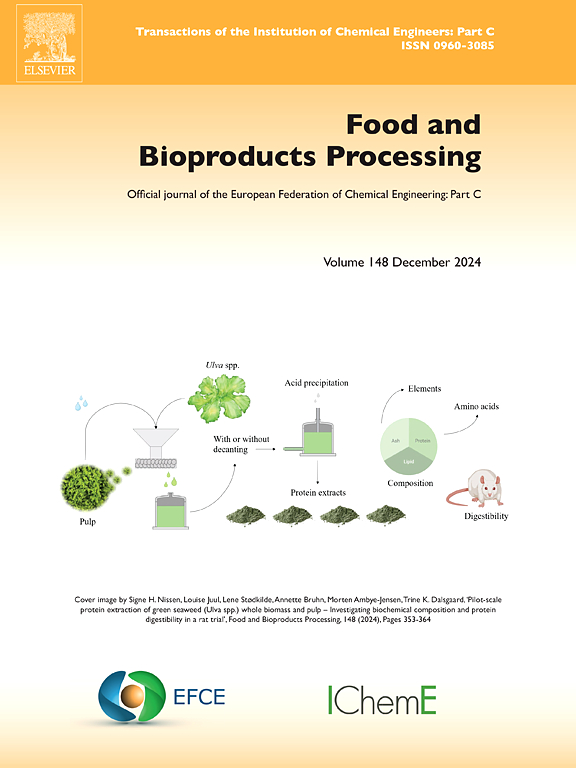Characterization of pickering emulsions stabilized by nano dietary fiber from Lentinula edodes stipes
IF 3.5
2区 农林科学
Q2 BIOTECHNOLOGY & APPLIED MICROBIOLOGY
引用次数: 0
Abstract
Waste Lentinula edodes (L. edodes) stipes from L. edodes were utilized as raw materials to obtain dietary fibers through a purification process. Following a 24-h cellulase hydrolysis, dietary fibers were subjected to cell disruption with varying durations. Differences in the monosaccharides composition, microscopic structure, size, zeta potential, contact angle, crystallinity, and functional groups of the nano dietary fiber produced through combined cellulase hydrolysis and cell disruption were analyzed in comparison to those obtained through cell disruption alone. Results indicated that the spacing between the nano dietary fibers was increased, and their particle size was reduced by cellulase hydrolysis followed by cell disruption. The wettability of the nano dietary fiber was enhanced by enzymatic treatment, whereas it was reduced by cell disruption. Either treatment did not compromise the crystalline regions of the nano dietary fiber; rather, the crystallinity was increased. Additionally, to emulsify corn germ oil, the prepared nano dietary fiber was employed, resulting in Pickering emulsion formation. A 45-min optimal cell disruption duration produced emulsions with a more uniform dispersion and the smallest particle size. Improved oil droplet encapsulation was exhibited by the emulsions prepared from dietary fiber that underwent cellulase hydrolysis followed by cell disruption, thereby leading to a decrease in free fatty acid release. The stability mechanism of the EEU24–30 emulsion was attributed not only to the adsorption of the nano dietary fiber onto the oil droplets but also to the formation of a three-dimensional network structure that further enhanced the emulsion stability.
香菇纳米膳食纤维稳定酸洗乳的表征
以香菇(L. edodes)的废叶柄为原料,通过提纯工艺获得了膳食纤维。在24小时的纤维素酶水解后,膳食纤维受到不同持续时间的细胞破坏。分析了纤维素酶水解和细胞破坏复合法制备的纳米膳食纤维在单糖组成、微观结构、大小、zeta电位、接触角、结晶度和官能团等方面与单纯细胞破坏法制备的纳米膳食纤维的差异。结果表明,纤维素酶水解后的细胞破坏使纳米膳食纤维间距增大,粒径减小。酶处理可提高纳米膳食纤维的润湿性,而细胞破坏可降低纳米膳食纤维的润湿性。两种处理都没有损害纳米膳食纤维的结晶区域;相反,结晶度增加了。另外,将制备好的纳米膳食纤维用于乳化玉米胚芽油,形成皮克林乳剂。45分钟的最佳细胞破坏时间产生的乳剂具有更均匀的分散和最小的粒径。由膳食纤维制备的乳状液经纤维素酶水解和细胞破坏后,油滴的包封性得到改善,从而导致游离脂肪酸的释放减少。EEU24-30乳状液的稳定机理除了归因于纳米膳食纤维在油滴上的吸附外,还归因于纳米膳食纤维在油滴上形成了三维网状结构,进一步增强了乳状液的稳定性。
本文章由计算机程序翻译,如有差异,请以英文原文为准。
求助全文
约1分钟内获得全文
求助全文
来源期刊

Food and Bioproducts Processing
工程技术-工程:化工
CiteScore
9.70
自引率
4.30%
发文量
115
审稿时长
24 days
期刊介绍:
Official Journal of the European Federation of Chemical Engineering:
Part C
FBP aims to be the principal international journal for publication of high quality, original papers in the branches of engineering and science dedicated to the safe processing of biological products. It is the only journal to exploit the synergy between biotechnology, bioprocessing and food engineering.
Papers showing how research results can be used in engineering design, and accounts of experimental or theoretical research work bringing new perspectives to established principles, highlighting unsolved problems or indicating directions for future research, are particularly welcome. Contributions that deal with new developments in equipment or processes and that can be given quantitative expression are encouraged. The journal is especially interested in papers that extend the boundaries of food and bioproducts processing.
The journal has a strong emphasis on the interface between engineering and food or bioproducts. Papers that are not likely to be published are those:
• Primarily concerned with food formulation
• That use experimental design techniques to obtain response surfaces but gain little insight from them
• That are empirical and ignore established mechanistic models, e.g., empirical drying curves
• That are primarily concerned about sensory evaluation and colour
• Concern the extraction, encapsulation and/or antioxidant activity of a specific biological material without providing insight that could be applied to a similar but different material,
• Containing only chemical analyses of biological materials.
 求助内容:
求助内容: 应助结果提醒方式:
应助结果提醒方式:


